NZXT Kraken G10 Review: Liquid Cooling for Your GPU
by E. Fylladitakis on March 11, 2014 1:15 AM EST- Posted in
- Cases/Cooling/PSUs
- NZXT
- Water Cooling
- Kraken
- G10
The Kraken G10
Essentially, the Kraken G10 is just a steel bracket that locks onto an Asetek-based round waterblock and allows its installation on graphics cards. NZXT offers the Kraken G10 in three glossy colors: black, white and red. We received the black version of the bracket.
The paintjob is very good at the top of the bracket, with a very clean glossy finish, yet it's not very good on the bottom side of the bracket, as it is uneven and even sagging near the edges. It is the top side that will be visible once the cooler is installed on a card, yet a more careful paint job would not hurt. The company logo is etched on the side of the Kraken G10, in direct line of sight from a side panel window. Two large cable tie mounting points can also be seen, which can be used to hold the hoses and/or the cables of the liquid-cooler.
Installation
The installation of the Kraken G10 is fairly easy. Once the stock cooler of the graphics card has been removed, the 92mm fan should be installed on the bracket with its engine facing upwards. Then the bracket can be easily installed on the liquid-cooling block by using the same plastic locking ring included with the kit's CPU installation hardware. Ideally, the hoses should be facing towards the front side of the bracket, as the cable ties can be used to hide them behind the bracket.
Once the block+bracket assembly is complete, it is a simple matter of using the backplate and installation screws included with the G10 in order to attach it to a graphics card. The installation of the Kraken X40 kit with the aid of the Kraken G10 on an EVGA GTX770 is depicted in the gallery below.
Note that it may be necessary to remove more than just the main cooler of the graphics card; as shown below, the RAM/VRM heatsink of the graphics card prevented the block from seating on the GPU and had to be removed as well. This will vary according to your choice of GPU/card.


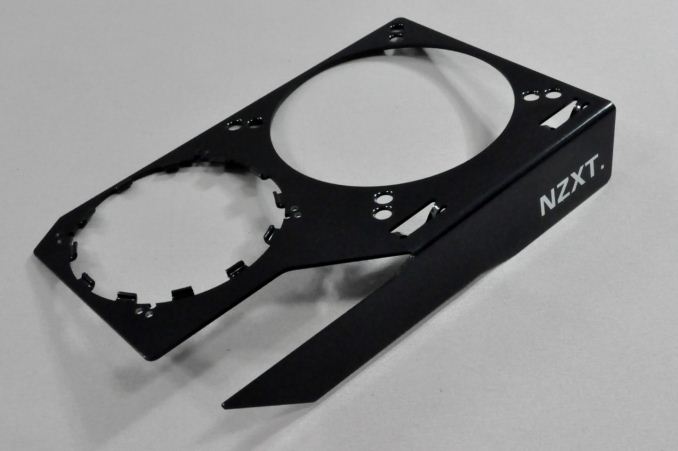
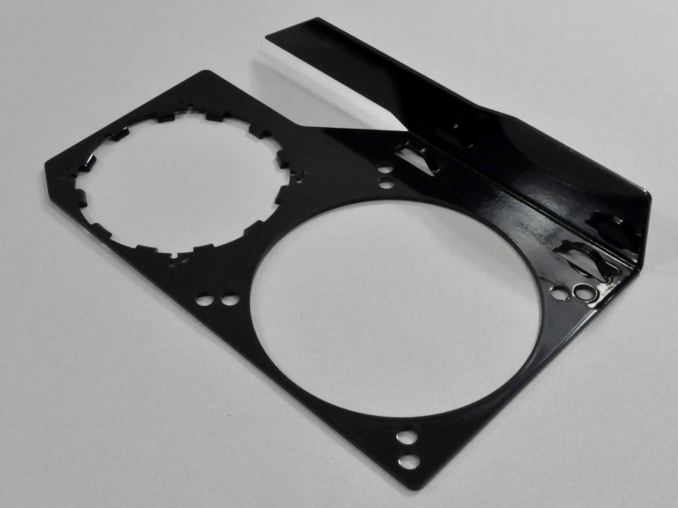
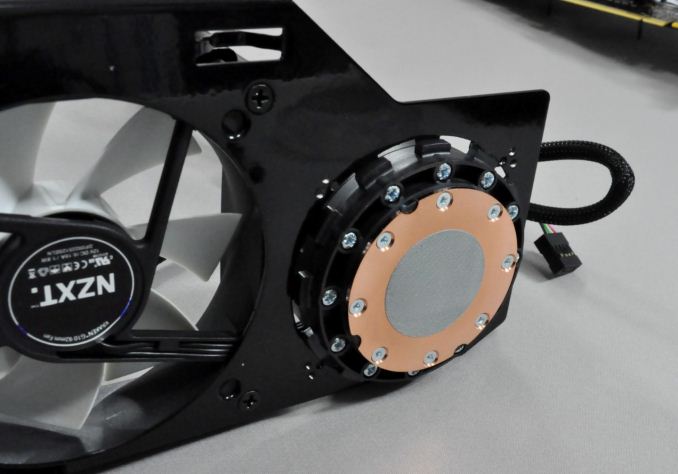
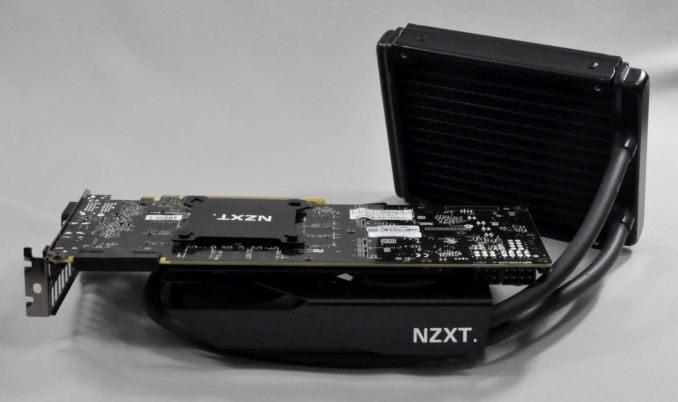
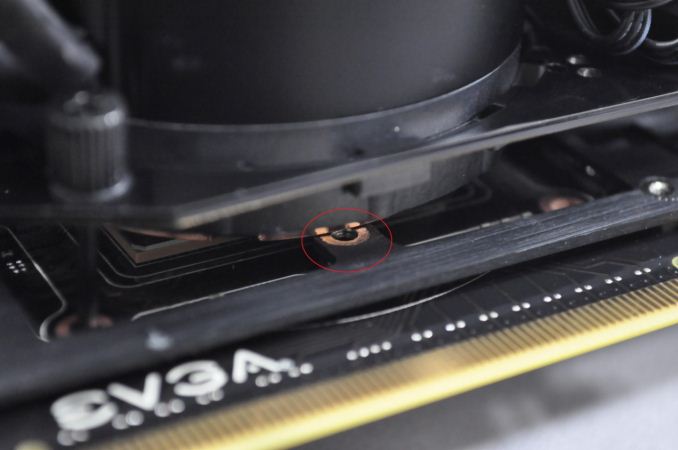








61 Comments
View All Comments
Bansaku - Tuesday, March 11, 2014 - link
Uhm, my Zalman CNPS20LQ (Asetek) pump is extremely quiet. In fact, no fan I have ever put in a case has been as quiet as most AIO coolers (from Asetek). I don't know where you get the idea that pumps are inherently noisier. Perhaps pumps from DIY kits.joelslaw - Tuesday, March 11, 2014 - link
Am I the only one who doesn't see a gallery on page 2? It says: "The installation of the Kraken X40 kit with the aid of the Kraken G10 on an EVGA GTX770 is depicted in the gallery below." but I only see 1 image below that.Redmenace - Tuesday, March 11, 2014 - link
Bottom line for the doubters...I had a 7950 in xfire on the top slot, overclocked and overvolted, which ran hot and 3000rpm loud and still hitting 80C. Installed this bracket with an X40 and just slapped the radiator on one of the existing 140mm case intake fans running at a constant 800rpm. Believe me, dumping two 92mm fans turning 3000rpm and replacing it with a 92mm fan (for the VRM's) running about 1300 is much quieter. Did not install any VRM heatsinks. Just adjusted the fan speed on the G10 fan enough to keep temps in the ballpark of the lower, cooler running 7950.biostud - Tuesday, March 11, 2014 - link
"Being nothing more than a steel bracket, the Kraken G10 essentially is a very simple product, yet it displays tremendous potential. One can wonder why no one else thought of this before (or at least, no one released a product like this until now)"Uhm, the Accelero hybrid which has been review on AnandTech in 2012 seems like a very similar product.
http://www.anandtech.com/show/6531/arctic-cooling-...
samsp99 - Tuesday, March 11, 2014 - link
I have wondered for a while why haven't the graphics card companies had any models with a built-in closed loop cooling solution? There are a couple of top end cards available with a water block, but nothing out of the box with a closed loop solution. The standard PC case design seems to be pretty bad from an airflow perspective for graphics cards, particularly for multiple cards. The cooling design seems to be one of the distinguishing factors between manufacturers, so having a closed loop option would seem to be a good idea. Fans on graphics cards seem to always be the noisiest and first to die in a build.Having a built in solution would allow for better fan/pump control so that they could adapt to the workload on the card.
Will Robinson - Tuesday, March 11, 2014 - link
Probably should've tried it on GTX480...that would have been a real torture test.NGR_ - Wednesday, March 12, 2014 - link
1 - Can AIO watercoolers made for 90W TDP CPU reliably cool ~250W TDP GPUs ?2 - In a case like a Fractal Design Define Mini (http://www.fractal-design.com/home/product/cases/d... where should the AIO watercooler be placed ?
3 - The G10 being out of stock, does anybody know if or when NZXT will be shipping new batches, or if other companies are preparing similar products (AIO watercoolers adaptors like the G10, or AIO GPU + watercooler) ?
E.Fyll - Wednesday, March 12, 2014 - link
1. TDP is a meaningless number in such cases. Some of these kits have a very good °C/W ratio. For exact performance figures, please refer to our AIO kit roundup. We tested all kits in that roundup with a real constant thermal load of up to 340 Watts. It would be fairly easy to assess the temperature of the card you would like to install a kit on by checking the °C/W rating of that kit and the estimated energy consumption of the card. Then, simply multiply the figures. For instance, if the kit has a thermal resistance of 0.1 °C/W and the card has an estimated power drain of 200 Watts, then the temperature will rise 0.1 × 200 = 20 °C above ambient.2. Well, depending on which AIO kit you will buy...wherever you like. I cannot possibly make an assessment for every environment, every case "like the Define Mini" and for every kit possible.
3. That I cannot answer, sorry.
JBVertexx - Wednesday, March 12, 2014 - link
The just announced Fractal Design Node 804 seems perfect for a dual-gpu completely water-cooled configuration using this adapter, although that's a lot of dough needed for 3 CLCs plus 2 of these brackets.http://www.fractal-design.com/home/product/cases/n...
theNiZer - Tuesday, March 18, 2014 - link
E. Fylladitakis : Nice review, but I don't get your point when you write: "One such limitation is that the fans of the liquid-cooling kit cannot be thermally controlled in relation to the temperatures of the graphics card. When installing such a kit on the CPU, the fans can be thermally controlled by the motherboard, but that's not an option here. Although fan control is partially possible for the kits with USB interfaces, such as the Kraken X40/X60 that were used for this review, this control is limited to the predefined settings of the user and does not adjust automatically depending on the load of the card."X40/X60 works the way you (and I) want - when the GPU heats the watercooling unit, the fans starts spinning more automatically. How is that not automatic and just like the way it works, had it been controlled by the motherboard??